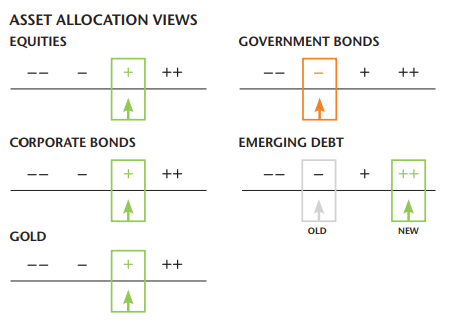Wealth Strategies
Enjoy A Vaccine-Inspired Boost Before "Japanification" Comes Back

A Swiss private bank says that certain long-term trends of lower growth and interest rates - sometimes likened to Japan's experience of recent decades - will persist in much of the world. However, the surge in growth and confidence stemming from vaccines for the virus may give investors a chance to enjoy some reflationary moves.
As thoughts turn to what markets may hold in 2021, we are
starting to compile a range of views and reflections from various
private banking houses. Here are thoughts from the team at
Geneva-based SYZ Private
Banking.
Adrien Pichoud, chief economist, and Fabrice Gorin, senior
portfolio manager at SYZ Private Banking, set out their
thoughts. As always, the usual editorial disclaimers apply.
To join the debate, email tom.burroughes@wealthbriefging.com
and jackie.bennion@clearviewpublishing.com
Although the global economy remains mired in a “Japanification”
scenario – the prevailing state of lower rates and slower growth
– positive news of a COVID-19 vaccine was a boost for risk
assets. In the short-term, this could trigger an acceleration in
both growth and inflation – a reflation. If this materialises,
investors should capitalise on the temporary shift, before we
return to the deeper, more profound deflationary cycle.
Within the Japan-style scenario, market cycles still occur, but
the episodes are typically milder and shorter. For example, risk
assets rose off the back of very accommodative central banks and
synchronised global growth in 2017, before being dragged back
down by the Federal Reserve reversal on monetary policy.
Similarly, we believe that the global economy will experience a
positive mini-reflationary cycle in the coming months – and
investors need a tactical response to capitalise on it before it
fades away.

Reflation requires coordinated global growth and a supportive
policy environment. As optimism over a post-COVID-19 return to
normal sweeps through markets and economic data adjusts
accordingly, we expect these conditions to transpire over the
next six months. However, evaluating the impact of the second
wave of COVID-19 will be crucial before we can be sure of a
reflation.
Flexible in fixed income
Acknowledging the rising possibility of a reflation, we have
tactically increased risk exposure through our fixed income
allocation. We have reinforced our bias to hard currency emerging
market debt, which has lagged the credit recovery so far. Spreads
are attractive compared to the broader market and emerging market
assets should benefit from a reflation scenario. A combination of
global growth, higher risk appetite and a softer dollar is the
sweet spot for emerging market debt.
In addition, to counter the rising probability of interest rate
increases and steepening yield curves in a global growth
environment, we have further reduced duration in the portfolios.
We did this by selling long-dated positions, notably US
treasuries, as the US curve appears most prone to a bear
steepening. We also took some profits on long-dated corporate
bonds, as valuations become less appealing.
However, credit remains attractive compared with cash and
government bonds in the risk-on environment, and we have
implemented hedges that allow us to maintain some exposure to
credit spreads while containing the impact of a potential rise in
rates. We still have a mild preference for high yield, with
attractive valuations, but the deterioration in credit
fundamentals warrants remaining selective.
By reacting to shifts in economic dynamics through tactical moves
like these – taking advantage of expected mini-cycles in asset
prices – we are able to generate positive performance in spite of
the low rate environment – even on negative yielding assets.
Dynamic asset allocation and tactical positioning are key for
navigating the current environment of very low interest rates, as
this allows us to capitalise on even the shortest and mildest of
reflationary cycles.
Dynamic approach to equities
On the equities side, we are also preparing to make strategic
adjustments. Given our conviction that we will ultimately return
to a Japan-like scenario, we do not believe value can sustainably
outperform growth.
However, if the impact of the second wave of COVID-19 is
relatively mild and coordinated global growth is reignited, there
will be an opportunity to tactically increase our cyclical
exposure in the short term to drive alpha within the
portfolios.
While our portfolios have a growth bias, we also have some
cyclicality in the equity allocation – so we will not be
wrong-footed if a rotation materialises early. Our overweight to
quality companies includes some industrial names and other more
cyclical stocks. If we see confirmation of positive global
growth, we will consider increasing cyclicality in the portfolios
in the short term. Core eurozone equity markets, such as France
and Germany, are particularly attractive given the super-low rate
context in Europe.
Meanwhile, structurally, we are increasing our exposure to
emerging markets – specifically China, as we see long-term
potential for the country catching up with developed market
peers. Chinese equities, which have lagged for the last five
years, are currently benefiting from the low-rate environment and
global growth pickup, in addition to the authoritarian
government’s handling of the COVID-19 pandemic.
The country has not witnessed a second wave of infections, and
liquidity injections and fiscal support have boosted domestic
credit growth. We are playing this through a combination of ETFs,
to provide us with exposure to Hong Kong listed giants, such as
Alibaba and JD.com, as well as domestic A-shares, which are less
dependent on the foreign environment.
Within the Japanification framework, reflationary episodes will
occur. While these events will create short-term volatility, they
will also provide valuable windows for multi-asset portfolio
managers to dynamically deliver additional alpha. At SYZ, we
embrace these opportunities to demonstrate the value of active
management.
